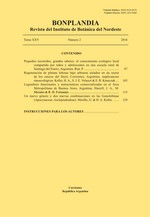Evaluation of phytoplankton and water quality of a subtropical stream in the Northwest of Argentina
DOI:
https://doi.org/10.30972/bon.2723536Keywords:
Abiotic and biotic variables, Argentina, Calimayo stream, microalgae, polluted effluents, TucumánAbstract
The Calimayo stream is part of the Salí river basin, the main fluvial network in the region. This lotic system was recognized for its great biodiversity. The settlement of a paper industry altered its ecological conditions due to the production of polluting effluents. The aim of this study was to analyze the phytoplankton of the Calimayo stream in relation to water quality. Sampling was done under a seasonal basis from Winter 2012 to Autumn 2013 at three sites S1, S2, and S3. Environmental and biological samples were collected following standard procedures. The highest values of temperature, pH and electric conductivity were registered in sites S2 and S3. Site S1 had the maximum values of dissolved oxygen and the lower biochemical oxygen demand. Diatoms excelled qualitatively and quantitatively among the other algal groups. Redundancy analysis (RDA) allowed to differentiate two phytoplanktonic groups related to abiotic variables. Site S1 was influenced by seasonality, relief, lithology and physicochemistry of water, denoting good ecological conditions. At S2 and S3 the phycoflora was affected by the trophic state of the water and the pollutants, which caused a notable deterioration of water quality and phytoplankton. Phytoplankton resulted to be a good indicator of the ecological conditions of this lotic system. We can affirm that the limnological conditions of the Calimayo stream from the 90s to the present have been degraded to the presence of industrial effluents.Downloads
Download data is not yet available.
Downloads
Published
2018-11-20
How to Cite
Taboada, M. de L. Ángeles, Martínez De Marco, S., Alderete, M., Gultemirian, M. L., & Tracanna, B. C. (2018). Evaluation of phytoplankton and water quality of a subtropical stream in the Northwest of Argentina. Bonplandia, 27(2), 135–155. https://doi.org/10.30972/bon.2723536
Issue
Section
Original papers
License
Declaration of Adhesion to Open Access
- All contents of Bonplandia journal are available online, open to all and for free, before they are printed.
Copyright Notice
- Bonplandia magazine allows authors to retain their copyright without restrictions.
- The journal is under a Creative Commons Attribution 4.0 International license.















.jpg)


